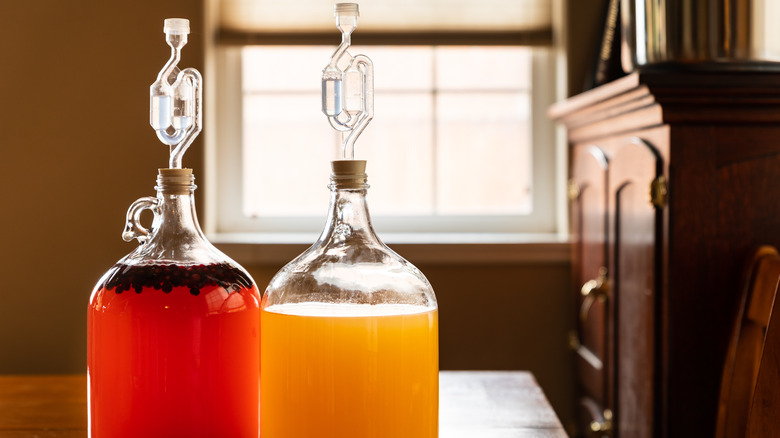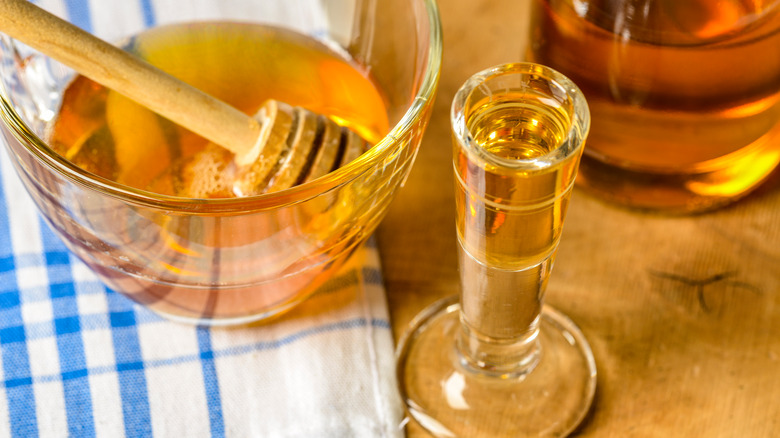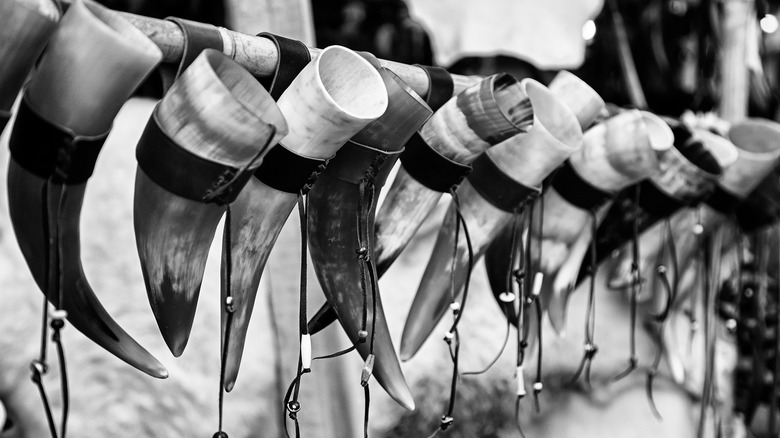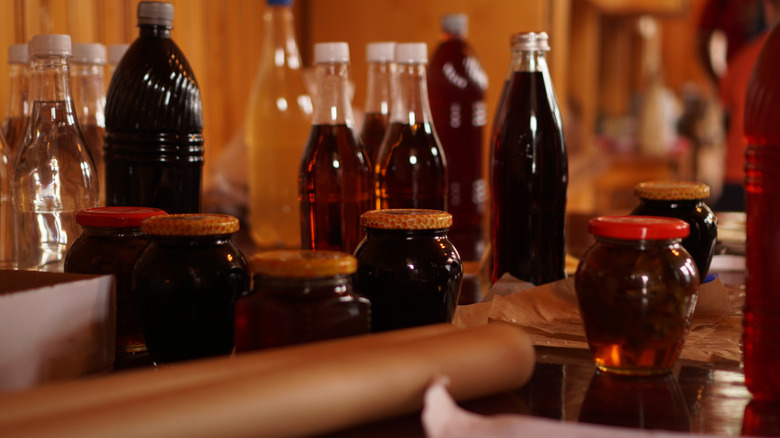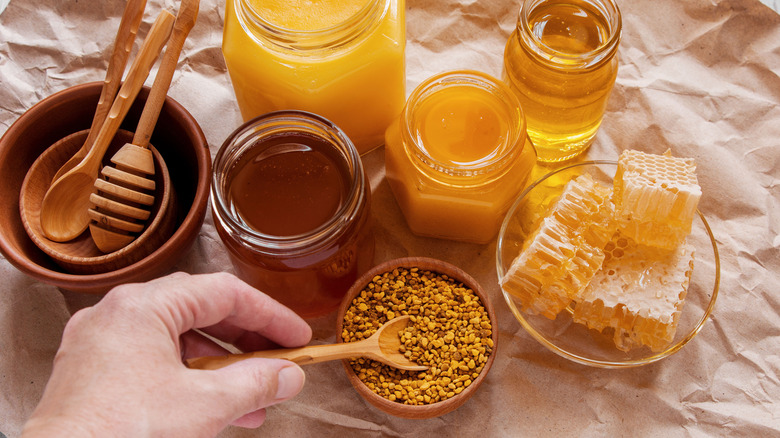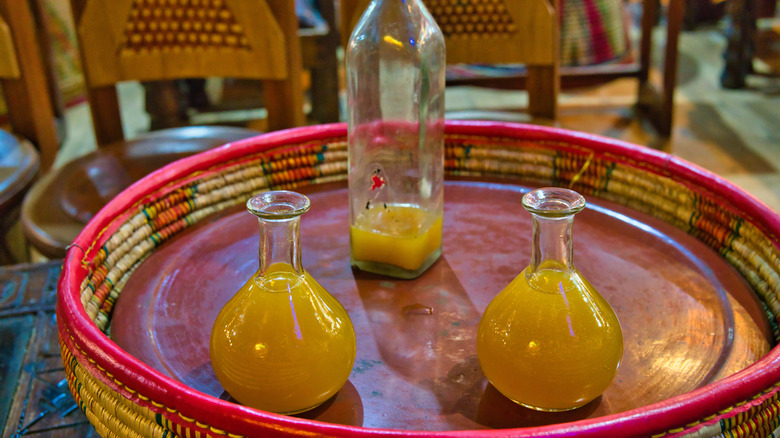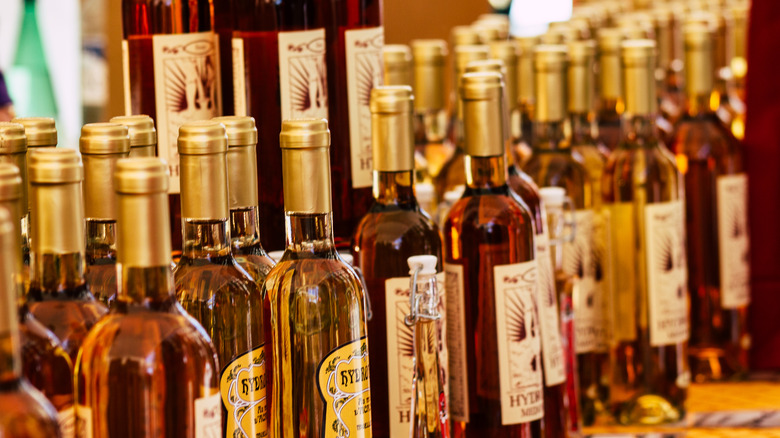Everything You Need To Know About Mead
Somewhere between wine, beer, and cider lives mead. An ancient libation like no other, mead has been a pleasant surprise to drinkers for eons. Norsemen would be thrilled to know that it has made a modern-day comeback. Often tied to medieval history, the tasty honey-based concoction is as traditional as it is eclectic; appreciated by everyone from Vikings to millennials. Long before prohibition, drinkers were innovative when employing honey as a sweetening agent for fermentation, hence the common nickname "honey wine."
While oftentimes overlooked and under-appreciated over the course of its long existence, mead has reemerged and piqued the interest of many over the last few decades (via Vogue). Today, many mead makers use fresh seasonings and spices from around the world to modify their recipes. Californian mead maker Billy Beltz is quite creative when it comes to flavoring his creations with a wide range of ingredients from chili peppers to tangerines, just as long as it's 51% honey as reported in San Diego Union Tribune. If mead contains any lower percentage of honey, then it can't technically be called mead, regardless of the taste. Mead has evolved over the years but the simple fermenting steps remain, making the same deliciously unique beverage that our ancestors enjoyed.
How is mead made?
There's a reason mead didn't take too long for civilization to create, and that's due to its tiny list of ingredients. Originally crafted from merely honey and water, the delectable honey fermented drink falls under its own unique varietal that is easy to uniquely adapt. Nowadays yeast is typically added to speed up the fermentation process, according to Britannica. The sugars in honey are fermented over time to create the sweetened alcoholic beverage which offers a blank canvas for not only flavors, but also the level of carbonation and preferred alcohol content. Beer Connoisseur shares that the final product's alcohol-by-volume can range anywhere from 3% to more than 20%.
Much like wine and beer, not all meads are alike. Small factors play a huge role in the distinctive flavor notes such as the type of honey used and measurements. These elements can push mead in numerous directions, resulting in a sweet taste similar to a dessert wine, or as an elegant dry creation for those that shy away from sugars. If there is one rule when it comes to flavoring mead, it's that there are no rules. The honey fermenting process is rather autonomous, and then it's up to the mead maker to determine the rest. This spontaneity is part of what makes mead such a broad category with infinite opportunity for flavors.
What does mead taste like?
Mead can be a sweet delight with layers of complex flavors or tart for those that crave a drier sip (via Beer Connoisseur). The fermented beverage can wear a lot of coats. It can be fruity, creamy, earthy, bright, and even hoppy. In other words, there's a mead for almost anyone. While different spices and sweeteners can elevate a mead's flavor, the choice of honey will play a huge part in the tasting notes. As Ken Schramm points out in his book, "The Compleat Meadmaker," quality ingredients hold a stronger impact than a recipe when it comes to mead-making. Different kinds of honey will impact the mead's flavor, color, and consistency.
These varying flavors are partly what has led people to confuse mead with cider, wine, and even beer. While the ingredients may be simple, the mead-making process is not. The method can often begin the same, but anything from varying measurements to the temperature on a given day can impact the final flavor of the mead. With so many variables, the flavor possibilities are endless. Schramm makes it clear that the mead recipes he shares in his book are to act as a start, but that the individual mead maker is ultimately the one who adds their own touch.
The rich history of mead
Wine and beer may have been around for centuries, but chroniclers argue that mead was the first-ever alcoholic drink. The ancient roots of the beverage make the origin a little opaque, but Kinsale Mead Co. shares the many narratives as to its invention vary from region to region. Northern China is seemingly responsible for creating the first honey fermented drink back in 6500 B.C. and evidence of mead has been uncovered in European ceramics, some as old as 2800 B.C. Considering mead became independently appreciated by so many different cultures, the beverage has an abundance of variations.
It was said to have been a Viking favorite and was sipped from drinking horns carved from bones (via Vikings Brand). Ancient Greek lore notes that mead was enjoyed by the civilization. For their ancient Roman counterparts, it served less as a main component and more as a sweet sipper to pair with a wine called Mulsum that was sweetened with honey. Britannica adds that the vogue of honey-based alcohol stretched further than Greece during the Middle Ages. In fact, the Irish Examiner explains that the word "honeymoon" is derived from giving newlywed couples a month's worth (or "moon's worth") of mead. It wasn't until the 16th century that honey-fermented wine was granted its alternative name of metheglin, thanks to Welsh culture which adopted it as their own with added spices. As years carried on, other new liquors began trumping the popularity of mead, and "honey wine" ultimately became an antiquated sipper.
Mead made its way back onto bar shelves
Aside from the fact that it was the first and, for a period of time, the only alcoholic beverage, mead was once incredibly popular. Unfortunately, when sugar became more readily available in the 17th century, the industry shifted. Honey wasn't as easy to acquire and new sugar-heavy spirits began to develop in varying regions. Honey soon got swept aside as a fermenting option while wine and beer began to lead the industry.
After a lengthy lull, mead is making its way back into goblets all over the world. The American Mead Makers Association shares that since the early 2000s, the number of commercial meaderies in the states has continued to rapidly increase. As of 2020, there were approximately 450 meaderies, with another 50 alcohol producers creating at least one line of mead a piece. With only around 60 meaderies in operation back in 2003, that's a 650% increase within the last two decades. Douglass Miller of Cornell University's Hotel School, tells Vogue, "I think mead is making a comeback because of the rise of the craft beverage industry. You've seen breweries, distillers, and cider houses opening up all over the country. Mead is an untapped product that has potential growth."
Is the nectar of the gods really good for you?
Mead was once a lot more than just a mouthwatering drink, it was a symbol of exuberance. According to Healthline, mead apparently served as a pseudo-medicine to soldiers post-fight. It was said to have healing effects, although there's not much scientific evidence to back that statement. People may have been more trusting during ancient times or perhaps they just wanted to believe that getting a little tipsy on "honey wine" could ease their pangs.
The concept that mead is nutritious likely links back to the concoction's main ingredient, honey, which has well-known therapeutic and sweetening properties. The Mayo Clinic reports that honey contains a myriad vitamins and minerals, including antioxidants, iron, zinc, and amino acids. Cultures for Health, a company specializing in do-it-yourself fermenting and culturing kits, states that the fermentation process only boosts the pre-existing advantages of raw honey. Fermenting foods produces probiotics, which are excellent for gut health. Despite the many benefits of honey, Healthline reaffirms the lack of research supporting mead as a healthy drink of choice. Mead makers can only control the fermentation process to an extent, which is why each type of mead is uniquely delicious with inconsistent probiotic levels.
Switch it up with mead-centered cocktails and substyles
As delicious as mead is, it can be appreciated in more ways than just solo in stemware. Makers have gotten creative over the years by exploring unique additives and expanding on the variants of mead. Some riffs on traditional mead include the addition of beer or hops, which is called "braggot," and fruit, which is called, "melomel" (per Eater). These various types of honey-fermented libations have evolved from different cultures all over the globe for centuries, and many of those styles have been woven together today.
Considering its versatility, mead can be a fun complement to almost any drink. Just a few ounces of mead can function as a funky sweetener or a tart and unexpected bite in any unique cocktail. Wine Enthusiast shares some fun, crisp beverages starring "honey wine," with adjoining ingredients ranging from earthy aromatics to bright citrus and yuzu. San Francisco mixologist and owner of Fine & Rare, Ted Wilson, crafted a mead spritzer that keeps it light, utilizing notes of cardamom and kumquat (via Wine Enthusiast). While recipes make it clear that the beverage can operate as a tasty mixer, mead alone can taste as smooth and flavorful as a cocktail. Specific fermentation techniques and distinct, quality components allow for endless opportunities at meaderies. Drinkers have referred to mead as similar to sparkling cider and differing from the overly sweetened versions often sold at Renaissance fairs (via The New York Times).
Ready to become a mead-head?
If there was confusion regarding what category mead fell into, the liquor store isn't likely to solve any looming wonders. Considering it's still a bit of a niche drink of choice, mead can be difficult to locate at select liquor stores as it's often tucked away with either wine, beer, or other specialty liquors and spirits. The national sales manager of Chaucer's, America's longest-running meadery, confirms that the majority of shops have no clue what shelf to display mead on (per Thrillist).
Former Disney Channel star turned craftsman Dylan Sprouse reminded folks of its depth and versatility when debuting his own mead emporium in NYC, All-Wise Meadery. According to a database compiled by Mad Alche Mead, nearly every state now has at least one meadery in it. While craft beer culture continues to explode, let's not forget about mead. With its persistent rise in popularity, meaderies are becoming hangouts much like breweries.

